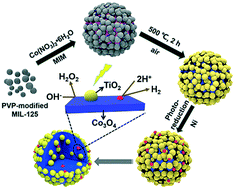Engineering a hetero-MOF-derived TiO2–Co3O4 heterojunction decorated with nickel nanoparticles for enhanced photocatalytic activity even in pure water†
Abstract
A highly porous ternary TiO2/Co3O4/Ni photocatalyst is successfully constructed from a hetero-metal organic framework (H-MOF) template and via a facile photoreduction method. The photocatalytic H2 production coupled with the formation of H2O2 on TiO2 is improved by co-loading an oxidation promoter (Co3O4) and a reduction promoter (Ni) owing to the following factors: porous Co3O4 promotes the optical-response ability and surface water oxidation kinetics of TiO2, and in situ photo-deposited Ni facilitates the transport and utilization efficiency of photo-excited electrons. Owing to the synergy of the improved specific surface area and improved separation as well as utilization of photogenerated charge carriers, the optimal ternary TiO2/5at%Co3O4/0.5at%Ni heterostructure exhibits a hydrogen production activity 8.7 times higher than that of pure TiO2, and demonstrates obvious photocatalytic hydrogen evolution even in pure water, with stoichiometric H2O2 production. This work will provide insights into the design and synthesis of noble metal-free dual cocatalyst systems for efficient charge separation and transfer.



 Please wait while we load your content...
Please wait while we load your content...